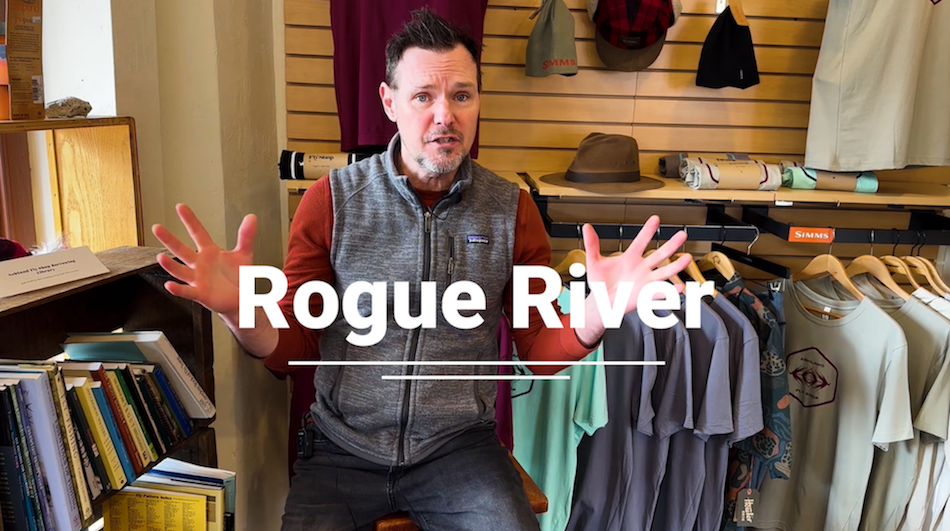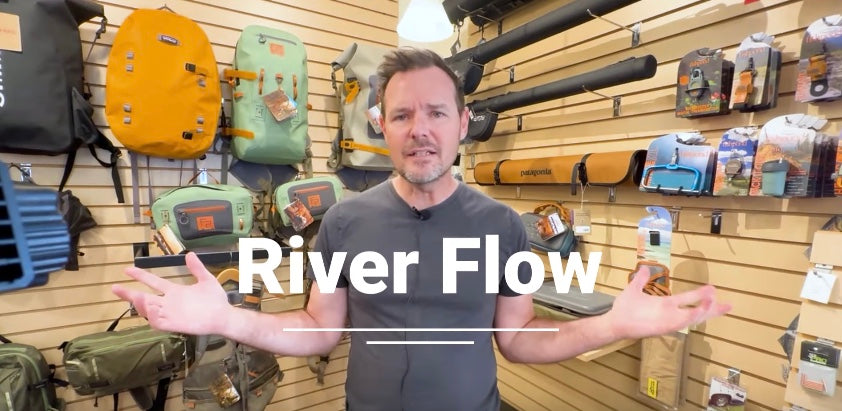Your Cart is Empty
free shipping on all domestic orders over $75
 Visual cues will help you solve the Spey Casting Equation
Visual cues will help you solve the Spey Casting Equation
For the last couple of years, I have been really stressing the importance of visual cues by seeing the components of your cast unfold as you set it up and deliver. From the casters perspective, you can see everything happen and therefore adjust as necessary. There are also things that you hear and feel during a spey cast. I refer to it as the "look, listen, and feel" method, as it relates to sustained anchor casting (double spey/snap-t type casts). See it happen, hear the good and bad sounds, and if it feels good, it probably was. I have heard for years from guys like Mike McCune and Scott O'Donnell to "be a watcher". It is the single most critical thing a spey caster can do. It is also the single most thing that is overlooked and hardest to convince my clients to do. The "look, listen, feel" is in sequence of importance. If you know what to look for, you can successfully self-diagnose and fix and casting problems that arise just by what you see. There are good and bad sounds that reinforce what you see. A blown anchor, for example, can make sounds like "whoosh or crack". You should see and hear it simultaneously. Your first visual cue is your anchor placement. Your fly should be about a rod length off of your casting side. The end of your floating line is your visual. Once you lift and set your anchor, you should see where it lands every time. For Skagit lines, the connection between the floating portion and sink-tip should be right in front of you at the completion of your anchor stroke. For floating lines, the same rule applies except you may have a versa-leader or regular mono leader connection. It is critical that your anchor placement be accurate and consistent. It is like addressing a golf ball. It has to be in the same part of your stance every time. [caption id="attachment_2282" align="aligncenter" width="625"] My first visual cue: The golf ball, where the end of the blue spey line meets the sink tip.[/caption] Once your anchor is right, initiate your D-Loop Stroke, make your D-Loop and let it rip. But, as your D-Loop forms, you must be able to see how much anchor stick you have left prior to the forward cast. More on that later. Sustained anchor casts start with an anchor and end with an anchor. You need to see it from start to finish. Your anchor is your point of reference. Without it, you are casting blind. I believe that to become a good caster, you must be tuned in to this concept. When I watch people cast, I know as soon as I see the D-Loop and remaining anchor what the result will be. As a caster, you must train yourself to do the same. It is no different than single hand casters watching their back cast. Just as single handers see the back cast straighten out, a spey caster must see the anchor pull straight as the D-Loop comes tight. By seeing a fault, you can make the proper adjustment on the next cast. [caption id="attachment_2283" align="aligncenter" width="625"]
My first visual cue: The golf ball, where the end of the blue spey line meets the sink tip.[/caption] Once your anchor is right, initiate your D-Loop Stroke, make your D-Loop and let it rip. But, as your D-Loop forms, you must be able to see how much anchor stick you have left prior to the forward cast. More on that later. Sustained anchor casts start with an anchor and end with an anchor. You need to see it from start to finish. Your anchor is your point of reference. Without it, you are casting blind. I believe that to become a good caster, you must be tuned in to this concept. When I watch people cast, I know as soon as I see the D-Loop and remaining anchor what the result will be. As a caster, you must train yourself to do the same. It is no different than single hand casters watching their back cast. Just as single handers see the back cast straighten out, a spey caster must see the anchor pull straight as the D-Loop comes tight. By seeing a fault, you can make the proper adjustment on the next cast. [caption id="attachment_2283" align="aligncenter" width="625"] My last visual cue: see the anchor straighten and pull tight, observe how much anchor is left, watching for the connection (color change) between sink-tip and spey line.[/caption] This brings up another concept that I came up with: The Casting Equation. Again, this concept relates mostly, but not entirely, to sustained anchor casting. The Casting Equation is: "The height of the D-Loop Stroke + the speed of the D-Loop Stroke = the amount of energy in the D-Loop and the amount of anchor stick left (or remaining) prior to the forward cast." You have to solve that equation every cast. To do so, you have to be aware by using the "look, listen, feel" approach. You have to figure out how much remaining anchor stick is required to perform a good cast. More so, you have to know how much D-Loop height and speed it takes to relieve the proper amount of anchor prior to the forward cast. How much is it? It varies, really. [caption id="attachment_2285" align="aligncenter" width="625"]
My last visual cue: see the anchor straighten and pull tight, observe how much anchor is left, watching for the connection (color change) between sink-tip and spey line.[/caption] This brings up another concept that I came up with: The Casting Equation. Again, this concept relates mostly, but not entirely, to sustained anchor casting. The Casting Equation is: "The height of the D-Loop Stroke + the speed of the D-Loop Stroke = the amount of energy in the D-Loop and the amount of anchor stick left (or remaining) prior to the forward cast." You have to solve that equation every cast. To do so, you have to be aware by using the "look, listen, feel" approach. You have to figure out how much remaining anchor stick is required to perform a good cast. More so, you have to know how much D-Loop height and speed it takes to relieve the proper amount of anchor prior to the forward cast. How much is it? It varies, really. [caption id="attachment_2285" align="aligncenter" width="625"] Monitoring the height and speed of your D-Loop Stroke is the essential part of the Spey Casting Equation[/caption] Let's back up a little. When you make, for example, a Double Spey, and the anchor stroke is complete, most of the spey line is laying (anchored) on the water in front of you, parallel to the bank and river. As you make your D-Loop Stroke, you are gradually peeling line off the water, gradually relieving anchor. Your goal is to relieve just enough anchor stick so that your forward cast "plucks" your leader off the water. As the D-Loop forms, it does two things: it pulls your line, leader (or sink-tip), and fly straight, inline with your target, and it creates load. If your D-Loop doesn't have enough energy to pull your line straight (inline with your target) you will be left with what Simon calls a "Bloody L". If you have too much speed and height your anchor will prematurely break loose (we call it a blown anchor) and all energy will be lost, the result will be a poor, piled cast with ugly sounds. So, figuring out how much speed and height is needed to pull your leader straight, inline with your target so that your forward cast can pluck your fly out of the water, is key. This all goes back to the casting equation. Too much height and speed on your D-Stroke relieves too much, too low and slow leaves you with too much anchor, a Bloody-L and no energy. Spey casting is about happy mediums. You have to find it. So, back to the question, how much anchor stick do I need prior to the forward cast? With sink-tips, you need about 10 feet of sink-tip anchored to "hold the load". It might be 8 or 12, depending of the size of your fly. But, on average, it is 10 feet. This is easily seen because of the color contrast between the floating portion and sink-tip. As your D-loop reaches it's potential and pulls tight, you should be able to see it. For floating lines, on average, your entire leader (12-20') should be your remaining anchor stick. Some experimentation is required to figure out what the optimal anchor is depending on how you are rigged. Once you have figured that out, you have solved the equation. You have to continue to solve it as you fish through a run. This is where your powers of observation come into play. Casting in ankle deep water is different from casting is waist deep water. As you wade deeper, you have to adjust the speed and/or height of your stroke to get the same anchor result because now your 13' rod essentially gets shorter as you wade deeper. As you wade deeper, you are fighting more line stick. Since speed and height regulate how line stick is relieved, speed and/or height must be increased, as you wade deeper. [caption id="attachment_2286" align="aligncenter" width="625"]
Monitoring the height and speed of your D-Loop Stroke is the essential part of the Spey Casting Equation[/caption] Let's back up a little. When you make, for example, a Double Spey, and the anchor stroke is complete, most of the spey line is laying (anchored) on the water in front of you, parallel to the bank and river. As you make your D-Loop Stroke, you are gradually peeling line off the water, gradually relieving anchor. Your goal is to relieve just enough anchor stick so that your forward cast "plucks" your leader off the water. As the D-Loop forms, it does two things: it pulls your line, leader (or sink-tip), and fly straight, inline with your target, and it creates load. If your D-Loop doesn't have enough energy to pull your line straight (inline with your target) you will be left with what Simon calls a "Bloody L". If you have too much speed and height your anchor will prematurely break loose (we call it a blown anchor) and all energy will be lost, the result will be a poor, piled cast with ugly sounds. So, figuring out how much speed and height is needed to pull your leader straight, inline with your target so that your forward cast can pluck your fly out of the water, is key. This all goes back to the casting equation. Too much height and speed on your D-Stroke relieves too much, too low and slow leaves you with too much anchor, a Bloody-L and no energy. Spey casting is about happy mediums. You have to find it. So, back to the question, how much anchor stick do I need prior to the forward cast? With sink-tips, you need about 10 feet of sink-tip anchored to "hold the load". It might be 8 or 12, depending of the size of your fly. But, on average, it is 10 feet. This is easily seen because of the color contrast between the floating portion and sink-tip. As your D-loop reaches it's potential and pulls tight, you should be able to see it. For floating lines, on average, your entire leader (12-20') should be your remaining anchor stick. Some experimentation is required to figure out what the optimal anchor is depending on how you are rigged. Once you have figured that out, you have solved the equation. You have to continue to solve it as you fish through a run. This is where your powers of observation come into play. Casting in ankle deep water is different from casting is waist deep water. As you wade deeper, you have to adjust the speed and/or height of your stroke to get the same anchor result because now your 13' rod essentially gets shorter as you wade deeper. As you wade deeper, you are fighting more line stick. Since speed and height regulate how line stick is relieved, speed and/or height must be increased, as you wade deeper. [caption id="attachment_2286" align="aligncenter" width="625"] The moment the D-loop pulls tight, observe how much sink-tip (or leader) is anchored, and if the result is good, you have solved the equation. Remember, the height and speed of the D-Loop Stroke determines how much anchor stick is left, at this very moment. [/caption] Another concept to consider is what I call "anchor range". I coined this phrase while observing a student during a lesson who was casting with too much anchor. As he ramped up the height and speed of his D-Stroke, his anchor relief became greater until he finally blew his anchor. We found his "anchor range". By his powers of observation, he was able to stay within his "anchor range", and narrow his window of range by fine tuning the amount of speed and height of his D-Stroke, effectively solving the casting equation and executing consistently good casts. Now, this all works as long as the timing is right between the formation of your D-Loop and forward cast. If you pause for a milli-second, your D-Loop will sag, fall to the water, and create line stick. So, make sure that as soon as your D-Loop has reached it's potential, you are initiating your forward cast. This can easily be controlled watching your D-Loop form and simultaneously watching your anchor pull straight and inline with your target prior to your forward cast. So remember, "look, listen, feel" as you solve the spey casting equation. Use your powers of observation and you will become a better caster. I guarantee it!
The moment the D-loop pulls tight, observe how much sink-tip (or leader) is anchored, and if the result is good, you have solved the equation. Remember, the height and speed of the D-Loop Stroke determines how much anchor stick is left, at this very moment. [/caption] Another concept to consider is what I call "anchor range". I coined this phrase while observing a student during a lesson who was casting with too much anchor. As he ramped up the height and speed of his D-Stroke, his anchor relief became greater until he finally blew his anchor. We found his "anchor range". By his powers of observation, he was able to stay within his "anchor range", and narrow his window of range by fine tuning the amount of speed and height of his D-Stroke, effectively solving the casting equation and executing consistently good casts. Now, this all works as long as the timing is right between the formation of your D-Loop and forward cast. If you pause for a milli-second, your D-Loop will sag, fall to the water, and create line stick. So, make sure that as soon as your D-Loop has reached it's potential, you are initiating your forward cast. This can easily be controlled watching your D-Loop form and simultaneously watching your anchor pull straight and inline with your target prior to your forward cast. So remember, "look, listen, feel" as you solve the spey casting equation. Use your powers of observation and you will become a better caster. I guarantee it!

A February fishing report from Will, covering current and upcoming river and weather conditions on the Rogue, Applegate, Umpqua, and several rivers in northern California!

